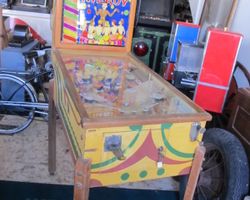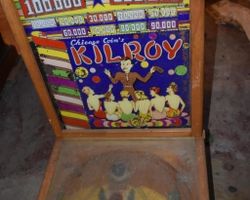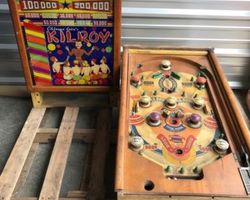
Average Prices: USD $100 to $400
Produced: January, 1947
Machine Type: Electro-mechanical
Players: 1
Design by: Jerry Koci
Art by: Roy Parker
Kilroy, a captivating pinball machine released in January 1947 by Chicago Coin Machine Manufacturing Company, offers a distinct glimpse into the early evolution of the pinball industry. With a production run of approximately 8,800 units, it stood as a significant release for its time, captivating players with its unique gameplay. The machine's name and theme are directly inspired by the popular World War II-era graffiti, "Kilroy was here," a phrase scrawled by American soldiers in various, often unexpected, locations across the globe. This ubiquitous cultural phenomenon, whose precise origins remain debated but appeared by late 1939, lent itself perfectly to a game designed to evoke a sense of widespread, playful presence.
History and Background
Chicago Coin, a prominent manufacturer during the electro-mechanical (EM) era, was responsible for bringing Kilroy to life. The design credit for this particular machine goes to Jerry Koci, who conceptualized the gameplay, while the distinctive artwork was created by Roy Parker. Parker’s artistic contributions were crucial in visually translating the playful, almost mischievous spirit of the "Kilroy was here" phenomenon onto the machine's backglass and playfield. The 1940s marked a pivotal period for pinball, evolving from mere gambling devices to skill-based games. Kilroy, introduced just after the war, resonated with a public familiar with the phrase, imbuing the game with immediate cultural relevance. Its substantial production numbers indicate a positive market reception, cementing its place as a memorable machine of its era.
Signature Features and Design
Kilroy is most notably defined by its flipperless design, a characteristic that places it firmly in the early lineage of pinball machines before flippers became a standard feature. This absence necessitates a completely different approach to gameplay, focusing heavily on the initial ball launch and the strategic layout of the playfield elements. The machine features ten passive bumpers, which act as static obstacles and scoring opportunities, along with four kick-out holes. The artwork, a central element, is imbued with the lighthearted, almost cartoonish depiction of Kilroy peeking over various surfaces, consistent with the popular graffiti. The backglass lights contribute to the visual appeal, drawing players into the machine's thematic world. The cabinet adheres to a normal, upright design typical of the period, housing the intricate electro-mechanical components that power its scoring and game progression.
Playfield and Mechanics
The playfield of Kilroy is meticulously designed to maximize interaction without the aid of player-controlled flippers. The layout strategically places the ten passive bumpers across the upper and mid-sections, acting as prime targets for rebounds. Each bumper offers scoring potential, with specific "dead bumpers" rewarding significant points like 10,000 and 140,000, though these are particularly challenging to hit. Four distinct kick-out holes are scattered across the playfield, each offering varying levels of difficulty for a successful shot. One of these holes functions as a repeater, allowing for repeated scoring if the ball lands there multiple times.
The flow of the game relies entirely on the player's skill in launching the ball using the manual plunger and the subsequent physics of gravity and rebound. Players must master the "shooter gauge" to control the power and trajectory of their initial shot, aiming to guide the ball into specific scoring zones or kick-out holes. The artwork on the playfield reinforces the "Kilroy was here" theme, with detailed illustrations that complement the mechanical elements. The placement of posts further influences the ball's trajectory, adding another layer of strategic depth to the flipperless environment. The overall aesthetic, through vibrant art and purposeful lighting, creates an engaging experience that is both visually appealing and mechanically intricate for its time.
Gameplay Dynamics
Gameplay on Kilroy is a study in precision and prediction. With no flippers to manipulate the ball once launched, the entire experience hinges on the player's ability to execute a well-aimed initial shot and understand how the ball will interact with the playfield's numerous passive elements. Scoring primarily involves hitting the passive bumpers, getting the ball into the side ball lanes, and successfully landing the ball in the kick-out holes. Each kick-out hole offers a unique challenge, with one, in particular, located between triangle plastics, proving especially difficult to access.
The game's progression is straightforward: accumulate points to earn replays or achieve a high score. Players often strategize by adjusting the strength of their plunger shot, attempting to direct the ball towards the higher-value bumpers or the more rewarding kick-out holes. The challenge lies in the rapid potential for ball drains, making each shot a high-stakes endeavor. Despite this inherent difficulty, the game offers a satisfying test of skill. The adjustability of the shooter gauge and the strategic placement of posts allow for a degree of customization, influencing how easily free games can be awarded, thereby adding replayability and a subtle layer of control over the game's difficulty.
Reception and Legacy
Kilroy has garnered a positive reception within the pinball community, particularly appreciated for its unique contribution to pinball history as a flipperless machine. Its strengths lie in offering a different kind of gameplay experience compared to modern flipper-based machines, providing a "nice diversion" that highlights the foundational mechanics of early pinball. Collectors value its historical significance, especially when complete with original scorecards and tax stamps, which further authenticate its vintage appeal. The machine's multiple scoring opportunities, from hitting various bumpers to landing in kick-out holes and utilizing side lanes, ensure that players have varied objectives to pursue. The ability to adjust features like the shooter gauge and post placement also allows for a degree of control over game difficulty and reward, which was a sophisticated feature for its time.
However, Kilroy is not without its challenges. The flipperless nature inherently makes the game difficult, with quick ball drains being a common occurrence. Hitting the "dead bumpers" for higher scores is particularly demanding, and some kick-out holes are notoriously hard to access. Despite these difficulties, its legacy endures as a compelling example of 1940s pinball design. Kilroy stands as a significant machine in the evolution of pinball, showcasing the ingenious ways designers created engaging gameplay before the widespread adoption of flippers. It influenced later designs by demonstrating the importance of precise initial ball control and intricate playfield layouts for maximizing player engagement and replay value in a pre-flipper era. Its presence in collections worldwide speaks to its lasting appeal and its role in charting the course of pinball's remarkable journey.
Sponsored Links
 Ebay Listings
Ebay Listings
 Auction Results
Auction Results
| Cost | Location | Date |
|---|---|---|
| USD $85 |  Wisconsin, United States Wisconsin, United States |
29 October, 2025 |
| USD $130 |  Oklahoma, United States Oklahoma, United States |
25 May, 2020 |
| USD $250 |  Ohio, United States Ohio, United States |
15 February, 2019 |
| USD $500 |  Pennsylvania, United States Pennsylvania, United States |
16 December, 2018 |
| USD $1,500 |  Indiana, United States Indiana, United States |
17 November, 2012 |
| USD $99 |  Ohio, United States Ohio, United States |
17 September, 2007 |


Private Policy · Search Website · Contact Us
As an eBay Partner, we may earn a commission from qualifying purchases made through links on this site, at no additional cost to you.
All trademarks and copyrighted materials remain property of their respective owners. All other content copyright 2007 - 2025 Pinpedia.




